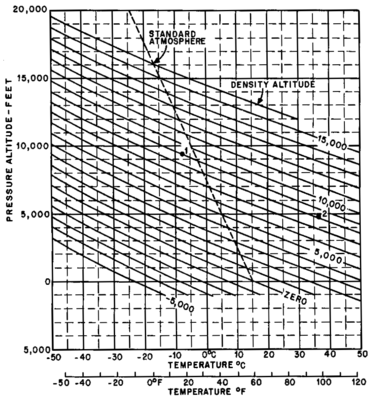- Density altitude
-
Density altitude is the altitude in the International Standard Atmosphere at which the air density would be equal to the actual air density at the place of observation, or, in other words, the height when measured in terms of the density of the air rather than the distance from the ground. "Density Altitude" is the pressure altitude adjusted for non-standard temperature.
Both an increase in temperature and, to a much lesser degree, humidity will cause an increase in density altitude. Thus, in hot and humid conditions, the density altitude at a particular location may be significantly higher than the true altitude.
Contents
Aircraft safety
Air density is perhaps the single most important factor affecting aircraft performance. It has a direct bearing on:[1]
- The lift generated by the wings — reduction in air density reduces the wing's lift.
- The efficiency of the propeller or rotor — which for a propeller (effectively an airfoil) behaves similarly to lift on wings.
- The power output of the engine — power output depends on oxygen intake, so the engine output is reduced as the equivalent "dry air" density decreases and produces even less power as moisture displaces oxygen in more humid conditions.
Aircraft taking off from a "hot and high" airport such as the Quito Airport or Mexico City are at a significant aerodynamic disadvantage. The following effects result from a density altitude which is higher than the actual physical altitude:[1]
- The aircraft will accelerate slower on takeoff as a result of reduced power production.
- The aircraft will need to achieve a higher true airspeed to attain the same lift - this implies both a longer takeoff roll and a higher true airspeed which must be maintained when airborne to avoid stalling.
- The aircraft will climb slower as the result of reduced power production and lift.
Due to these performance issues, a plane's takeoff weight may need to be lowered or takeoffs may need to be scheduled for cooler times of the day. Wind direction and runway slope may need to be taken into account.
Calculation
Density altitude can be calculated from atmospheric pressure and temperature (assuming dry air).
where
- DA = density altitude in feet
- P = atmospheric (static) pressure
- PSL = standard sea level atmospheric pressure (1013.25 hPa ISA or 29.92126 US))
- T = true (static) air temperature in kelvins (K) [add 273.15 to the Celsius (°C)] figure
- TSL = ISA standard sea level air temperature in kelvins (K) (288.15 K)
- b = 0.234969
Note that the leading coefficient is derived from the ratio of the ISA sea level temperature (288.15 K) to ISA Temperature Lapse Rate (6.5 K/km), with the product converted into feet.
National Weather Service Equation
The National Weather Service uses the following dry-air approximation of the above equation in their standards.
where
- DA = density altitude in feet
- P = Is the station pressure (atmospheric static pressure) in inches of mercury (inHg)
- T = T is the station temperature (atmospheric temperature) in Fahrenheit (F)
Note that the NWS standard specifies that the density altitude should be rounded to the nearest 100 feet.
Easy formula to calculate density altitude from pressure altitude
This is an easier formula to calculate (with great approximation) density altitude from pressure altitude ..and International Standard Atmosphere temperature deviation
- Density altitude in feet = pressure altitude in feet + (120 x (OAT - ISA_temperature))
Where:
- OAT = Outside air temperature in °C
- ISA_temperature = 15 °C - (1.98 °C/1000 ft × actual altitude in thousands of feet)
References and notes
- Air Navigation. Departments of the Air Force and Navy. 1 December 1989. AFM 51-40 / NAVAIR 00-80V-49.
- "Air Density and Density Altitude". http://wahiduddin.net/calc/density_altitude.htm. Retrieved 9 January 2006.
- Advisory Circular AC 61-23C, Pilot's Handbook of Aeronautical Knowledge, U.S. Federal Aviation Administration, Revised 1997
- http://www.tpub.com/content/aerographer/14269/css/14269_74.htm
 This article incorporates public domain material from the United States Government document "Pilot's Handbook of Aeronautical Knowledge".
This article incorporates public domain material from the United States Government document "Pilot's Handbook of Aeronautical Knowledge".See also
External links
Categories:- Aviation terminology
- Atmospheric thermodynamics
Wikimedia Foundation. 2010.


![\mathrm{DA} = 145442.156 \left[1-\left(\frac{P/P_{SL}}{\mathrm{T}/T_{SL}}\right)^b\right]](3/af33f9b45bf6345de9186081e6462bf9.png)
![\mathrm{DA} = 145442.16 \left[1-\left(\frac{17.326 P}{459.67+T}\right)^{0.235}\right]](9/49925e582878d4cd1331ce648231a92f.png)